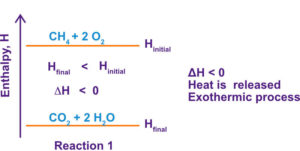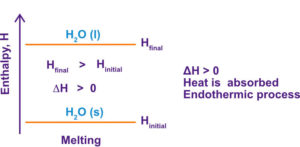In this study guide we will combine the state functions, E, V, and P to define another state function, enthalpy. Enthalpy, H, is defined as the quantity,
From the previous study guides, we know that
and
w = -PΔV Eq 2
At constant pressure q is equal to qp. Substitute pressure-volume work into Equation 1 for w, and qp for q.
Next, solve equation 3 for qp.
When q is measured at constant pressure, qp, ΔE + PΔV is equal to ΔH.
If q is measured at constant pressure, qp, the enthalpy change, ΔH, for a process or reaction can be determined.
The enthalpy change is:
The enthalpy change, ΔH, Eq 6, is the heat that is absorbed or released at constant pressure. For processes at constant pressure most of or all of the energy changes occur as a transfer of heat. We only need to measure initial and final conditions, Eq 7. Let’s look at three cases.
Case 1.
2 KI (aq) + Pb(NO3)2 (aq) → 2 KNO3 (aq) + PbI2 (s)
Solids and liquids undergo very tiny volume changes giving ΔV ≅ 0. This means that -PΔV ≅ 0 and ΔH ≅ ΔE
Case 2.
N2 (g) + O2 (g) → 2 NO (g)
There are 2 moles of gas on the reactant side of the equation and 2 moles of product gas. In this case ΔV = 0, -PΔV = 0, and ΔH = ΔE.
Case 3.
For reactions where there is a change in the number of moles of gas as in the formation of ammonia:
In most cases, ΔH is used to estimate ΔE. The amount of work that is done is usually very small when compared to the enthalpy change.
Enthalpy change, like enthalpy, is a state function,
where r is for reactants and p is for products. If ΔH < 0, heat is released and the process is exothermic. If ΔH > 0, heat is absorbed and the process is endothermic.
Hp > Hr Endothermic
You can think of a chemical reaction as a rearrangement of atoms. In order for a reaction to occur, the reactant bonds must be broken and new bonds are formed in the products. It takes energy to break bonds, and energy is released when new bonds are formed. If the energy released is greater than the energy absorbed to break bonds, then ΔH is greater than zero. If the energy released when forming new bonds is less than the energy required to break the reactant bonds, then ΔH is less than zero. More about this in a later study module.
We can think of heat as a product or a reactant. The following combustion reaction is an exothermic reaction–ΔH is less than zero.
The amount of heat released for the combustion of 1 mole of methane is -802.3 kJ. The negative sign is to indicate that heat is lost from the system (the reaction). We could write the above equation as:
For an exothermic reaction, heat is released and we can think of heat as a product.
The process of melting ice can be written as:
We see the melting (fusion) process is endothermic. It takes 6.01 kJ of thermal energy to melt 1 mole of ice. The equation can also be written to show heat as a reactant:
The sign of ΔH is positive, and melting is an endothermic process.
Worksheet: Enthalpy
Back to Thermochemistry
Back to General Chemistry 1 Study Guides
Back to Home Page


